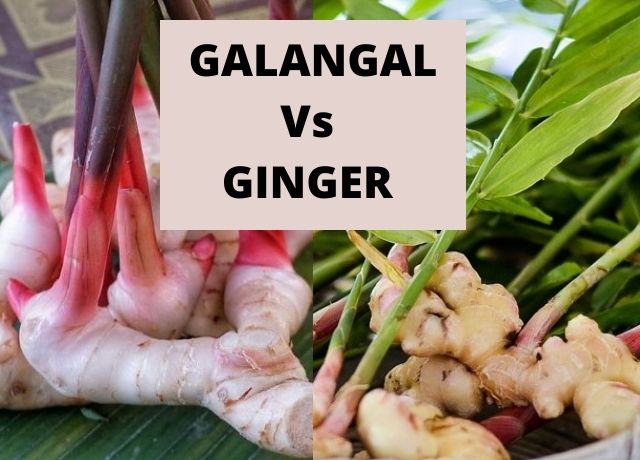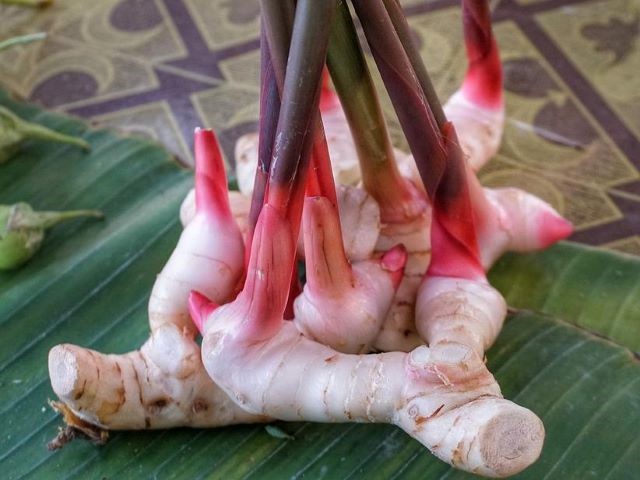While galangal and ginger might look very similar, they have very different tastes, and you wouldn’t want to mix the two up! When shopping for ingredients to add to your dishes, make sure you can tell the difference between galangal and ginger.
So what is the difference? How can you tell them apart? Do ginger and galangal have similarities? I’ll answer all of these questions in this post, and give you some delicious recipe ideas.

Table of Contents
Similarities Between Galangal and Ginger
There are actually quite a lot of similarities between galangal and ginger, which is why they can be difficult to tell apart. They both look very similar, both once harvested and as growing plants.
Both ginger and galangal plants have rhizomes under the soil, and long, green leaves above the soil. These leaves can grow quite big, and take up a lot of space. Both galangal and ginger can also have flowers, which are usually a light red or yellow-white.
Additionally, both galangal and ginger are rhizomes. In fact, they’re part of the same family — the ginger family. They grow very similarly, with similar needs, more on this below.
Galangal and ginger have so many similarities that sometimes, galangal is called Thai ginger. This is because it is very commonly grown and used in Thai cuisine, as well as other Asian cooking.
Differences Between Galangal and Ginger

Since galangal and ginger have so many similarities, what are their differences? While there may not be many differences, the ones they do have are important.
One of the biggest differences is in taste. Galangal has a much stronger, earthier taste than ginger does. Additionally, galangal is harder than ginger, with lighter skin. While you can shave ginger, galangal is usually sliced.
They are also both used very differently in cooking. Ginger is used as a seasoning for a wide variety of dishes, while galangal has fewer common uses. Galangal is sometimes removed from a dish before serving, but this isn’t something you’d usually do with ginger.
How Do You Tell Galangal and Ginger Apart?

When growing, galangal and ginger can be very hard to tell apart, as the plants look very similar. However, galangal plants sometimes have slightly wider leaves than ginger plants. Once harvested, though, it can be easier to tell them apart.
The skin of galangal is lighter than ginger, and smoother, not having quite as many bumps and ridges. So when shopping for one of these ingredients, use the color of the skin as a way to tell them apart.
Lastly, galangal has much harder skin than ginger. It is harder both on the inside and the outside. While ginger can be soft enough to peel and shave, galangal is much more firm, and usually has to be cut. If you pick up a ginger root and it’s got light, very hard skin, it’s probably not ginger at all, but galangal.
There is one other way to tell the two apart, although this won’t be easy to do at the store: taste. So how do they taste different?
Galangal Vs. Ginger: Taste
Perhaps the biggest difference between galangal and ginger is in their taste. They each taste very distinct, and you can’t substitute one for the other.
You’re probably familiar with the taste of ginger. It is a spicy, warming, sometimes peppery flavor. It can be slightly sweet. It’s strong, but usually not overpowering. It’s a taste that many people associate with gingerbread, the holidays, and family.
Galangal, on the other hand, has a much stronger taste. It’s earthy, sharp, and tastes like citrus. It also has notes of pine. It can very commonly be overpowering, and as a result, isn’t used in as many ways as ginger is.
So ginger is the classic, warm holiday spice people always think of (though it has a lot of other uses as well). Galangal is a much stronger, earthier flavor, one that’s good for soups and stews.
Growing Galangal and Ginger
Because ginger and galangal are both rhizomes from the same family, they have very similar growing and care needs. I’ll mention some of the basics here, so if you have one of these plants, you know how to keep them happy and healthy.
Whether in pots or in the ground, ginger and galangal need loose, well-draining soil. If the soil is too dense or compacted, they’ll struggle to push through it and grow well.
These plants also prefer partial shade. While they like a lot of bright, indirect light, they need to be protected from direct sunlight. Too much of it will cause the leaves to burn, as well as drying the soil out faster.
Don’t let your galangal or ginger plants dry out. Once the top inch of soil is dry, they should be watered. They don’t like to dry out completely.
Both ginger and galangal plants benefit from a well-balanced fertilizer a couple times a year. Homemade compost can work great for this.
Lastly, both ginger and galangal are perennial plants and, especially if grown indoors, can be grown continually. Once established, they can provide a fairly regular harvest, especially if you don’t need to take a lot at once.
Related: How To Grow Ginger: Guide To Growing Ginger At Home
Cooking With Galangal and Ginger
With all of their similarities and differences, how are galangal and ginger used in cooking?
Well, they actually have some different culinary uses, but here’s one similarity: both ginger and galangal can be found fresh, dried, or powdered. This opens up a lot of possibilities for different ways of using them in cooking.
Cooking With Ginger and Recipe Ideas
As I mentioned previously, ginger is soft, and easy to peel and shave, even with a spoon. So it is commonly included in all sorts of dishes and usually doesn’t need to be removed when cooking is done.
Ginger is a seasoning used for fish, meat, soups, and many other dishes. In its powdered form, ginger is a common ingredient in baked goods, and one of my favorite spices to use when baking. Ginger is also commonly used to make tea, and can help with an upset stomach, headaches, and other types of pain. Some people even add small slices of ginger to their water.
Ginger has so many culinary uses that you couldn’t get through all of the recipes using it. To get you started, though, here are some ideas:
- Tomato Chili And Ginger Jam Recipe
- Ginger Soy Fish
- Garlic and Ginger Shrimp Stir Fry
- Grandma’s Gingerbread Pancakes
Cooking With Galangal and Recipe Ideas
Galangal is much harder than ginger, and can’t be peeled or shaved as easily. As a result, it is typically sliced or sometimes crushed. Slices of galangal can be added to soups and stews. Because of its intense flavor, though, these slices are usually removed before serving the dish.
When crushed or powdered, galangal isn’t removed from the dish, but it is used sparingly. Crushed galangal is commonly used in curry pastes or other sauces to be incorporated into dishes. It can even be used to season meat and fish, but only if you use a very small amount.
All in all, galangal is a much stronger spice than ginger and is used more sparingly. When used correctly, though, it can be just as delicious!
Here are a few recipe ideas if you’d like to get started cooking with galangal:
Related reading:
- Are Ginger Leaves Edible? (And how to eat them!)
- Globe Artichoke Vs. Jerusalem Artichoke: What’s the Difference?
- Turnips Vs Radishes: What’s The Difference?
- Are Carrots a Fruit or a Vegetable? Answered!
- Tomato Chili And Ginger Jam Recipe
- Perennial Vegetables to Plant Once and Harvest Forever
- Is Sugarcane a Fruit or Vegetable?
